Healthy Buildings by Design
- By Lowell Tacker, Kate Mraw
- 09/01/16
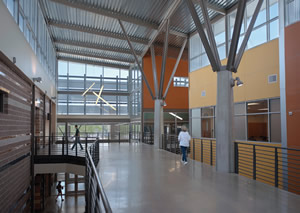
PHOTOS COURTESY OF LPA INC.
Due to the fact that, as humans, we spend almost
90 percent of our time indoors, it’s only natural that minor
improvements in the quality of the indoor environment can
have big impacts on our health. Sustainable initiatives and rating
systems have incorporated design strategies for healthy buildings
for nearly two decades. Only recently, however, has the conversation
elevated to a discussion around health and wellness and the impact
of the built environment on its occupants. As we learned recently at
an executive education course facilitated by the Harvard T.H. Chan
School of Public Health and U.S. Green Building Council (USGBC),
although there is abundant research regarding the impact of
daylighting, indoor air quality and the use of sustainable materials,
there is an industry gap in the research and applications of healthy
building design. The various rating systems such as LEED, CHPS,
and more recently, the WELL BUILDING Standards, are evolving
to recognize the impact of the built environment not only on our
health, but on our wellness and the well-being of future generations.
Buildings can be responsible for the major health challenges
we are facing today, including everything from obesity to asthma.
Alternatively, buildings can also positively promote human health,
particularly with focusing on the indoor air quality, active design
strategies, natural lighting and healthy material selection. We encourage
you to ask yourselves, “How might we design for human health?”
The World Health Organization (WHO) defines human health
as “our complete physical state of being free from disease or injury.”
Wellness, on the other hand, is the attitude one has towards
their health. It is a concept that one continually works for.
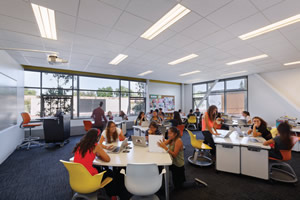
PHOTOS COURTESY OF LPA INC.
For buildings, how do we know when a building is healthy? How
do we know if our buildings promote wellness? Research studies
such as the #thecogFXstudy, led by Dr. Joseph Allen, show the impact of optimal air quality on cognitive function. Not only did
participants report a perception of better indoor environmental
quality, the research is a quantified study illustrating increases in
occupant productivity, critical thinking skills and decision making.
Applying this lesson to educational environments creates a
significant benefit for students’ health, engagement and learning.
Fortunately, the design of healthy buildings has become the norm
instead of the exception when it comes to educational facilities.
LEED and CHPS provided the early impetus while an increase in
student’s performance and a greater understanding of sustainability’s
value has continued the trajectory. It has been reported
that daylighting is associated with a 20-percent to 26-percent faster
learning rate and learning spaces with operable windows are seen
to be associated with seven percent to eight percent improvement in
student performance.
Indoor air quality (IAQ) is a major component of a healthy building.
For a new project this is something that should be addressed in
the planning stages to ensure the design, specifications and budget
accommodate measures needed to assure IAQ. Strategies include
protection of ductwork to prevent dust build up, multiple air changes
to “cleanse” the building, regular cleaning, protection from moisture,
use of high efficiency filtration media for mechanical units and
use of low-VOC or water-based adhesives and paints.
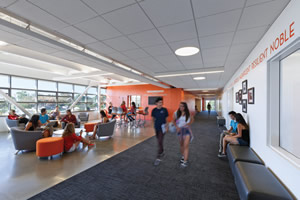
PHOTOS COURTESY OF LPA INC.
The need to address asthma and allergy issues has also become
more prevalent in today’s educational environment. Replacement
of carpet with hard flooring has been a common strategy to
enhance IAQ by removing those materials that trap dust and pollen.
New carpet technology is being developed so the nylon fibers
release the particulates rather that trap them. Better filtration is available for HVAC systems, an important
component given today’s outdoor air
requirements. The importance behind understanding
the factors that are associated
with indoor air quality can make a significant
impact on the quality of health of
your school environment. According to the
Center for Disease Control (CDC), school
absence due to illness such as asthma not
only affects individual students, but also
can affect other students who attend the
same schools. There is a community responsibility
that is connected to the health
and wellness of the educational environment.
According to the National Center for
Educational Statistics (2013), the average
age of American schools is 42 years old, as
schools undergo renovations, addressing
the indoor air quality is an opportunity to
positively impact student well being.
Several healthy strategies can be
included in a new or existing building, but
there are other factors that contribute to a
buildings health — especially aged buildings.
Prior to working in an older building,
a hazardous materials assessment should
be done. Usually a third-party specialty lab
is hired by the owner to survey and sample
the site for dangerous materials such as
asbestos and lead paint. Asbestos can be
found in a multitude of products (friable
and non-friable) including floor tile, mastic,
pipe insulation, glazing compounds and
other products. Lead paint is also prevalent
in older construction and can be buried
under multiple coatings that have built up
over the years. Once identified it can safely
be removed by specialty abatement contractors.
It is absolutely critical to include the
time to remove hazardous materials when
a project involves existing construction
and trying schedules. Recent events have
exposed lead water piping as another hazardous
component. If aged infrastructure is
prevalent it would be prudent to test for lead
and other contaminants.
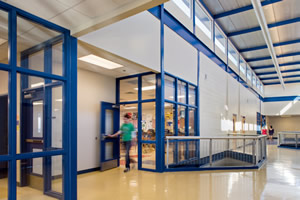
PHOTOS COURTESY OF LPA INC.
Mold is another obvious hazard. The
rules vary from jurisdiction to jurisdiction,
however in Texas, if there is more than 25
square feet of contiguous mold identified,
then a mold remediation protocol must be
developed and a licensed mold remediation
contractor must remove. Air sampling (an
industry standard) is the only way to tell if
the mold is airborne; basically findings are
compared to the species and concentrations
of the exterior, differences are identified that
will factor how the protocol is developed.
The remediation is similar to asbestos; build containment, use HEPA filtration, remove
in containment bags, clean and sample air.
The presence of mold indicates there is a
water and a food source for mold to live and
propagate. It is imperative to find and fix the
source of water intrusion, whether a leaky
pipe or building envelope issue. In Texas a
Certificate of Mold remediation damage can
only be issued after remediation and the
source of the mold has been fixed.
Beyond health, a focus on wellness and how
design can inspire social, mental and physical
health is an important aspect of healthy
schools. Social environments that include
open and communicative areas result in opportunities
for students to experience a sense
of connectedness on campus, to nature and
to their community. When children socialize
in natural environments, their play is more
diverse with imaginative and creative play that
fosters language and collaboration skills.
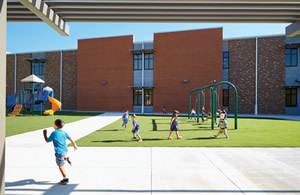
PHOTOS COURTESY OF LPA INC.
Design strategies that promote mental
health on campus is seen mostly in the
higher education market and more recently
in conversations at the high school level as
well. Creating spaces on campus that create
happiness and the ability to cope with stress
can reduce future health concerns for students.
Finally, understanding an approach
to design that encourages physical wellness
by creating design opportunities throughout
the school building or campus that encourage
daily exercise; spaces to engage in in
active learning, ergonomic seating and the
choice to stand in a learning environment,
walking trails and large central stairs that
discourage the use of elevators are all strategies
of active design that promote physical
wellness for students on campus.
The benefits of a healthy building are too
compelling to ignore. The increased benefits
to students, teachers and other occupants is
another example of the far reaching implications
good design has on the occupants.
Change design by seeing human health as a
must have, not as a nice to have.
Special thanks to Denice Williams, Baer Engineering and Environmental Consulting, Inc.
This article originally appeared in the issue of .